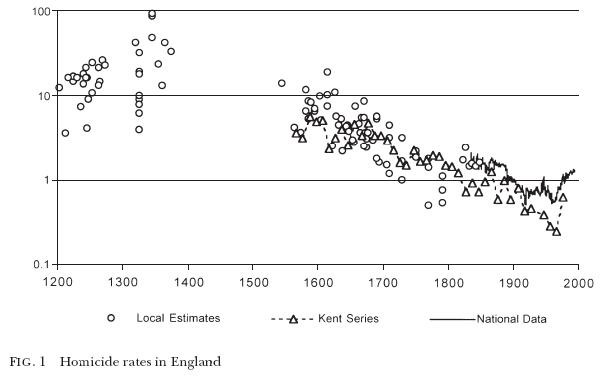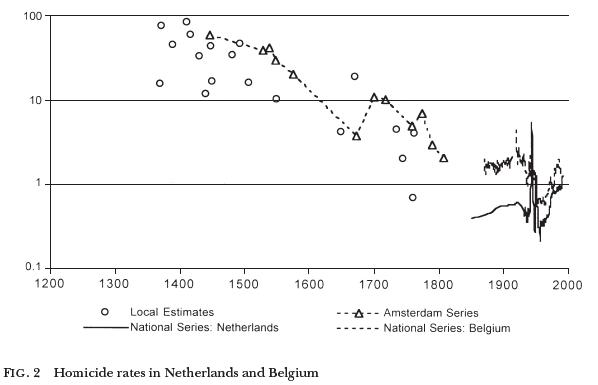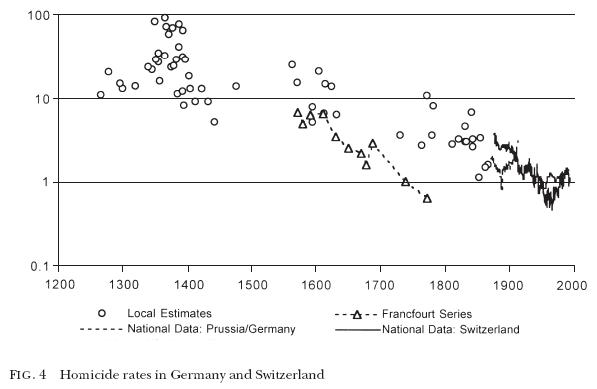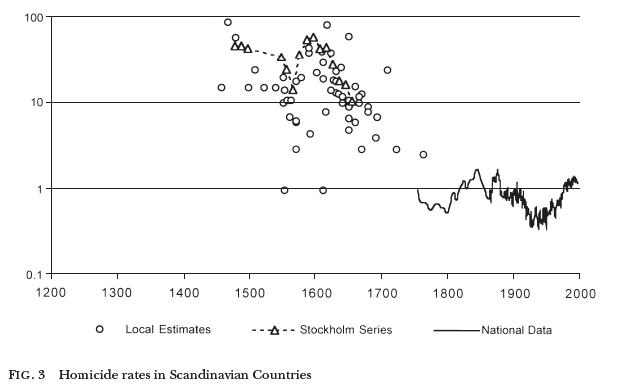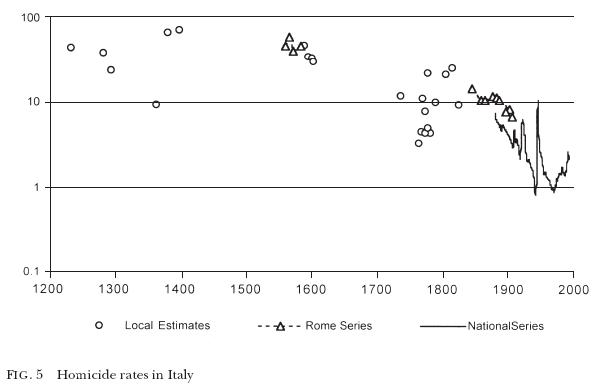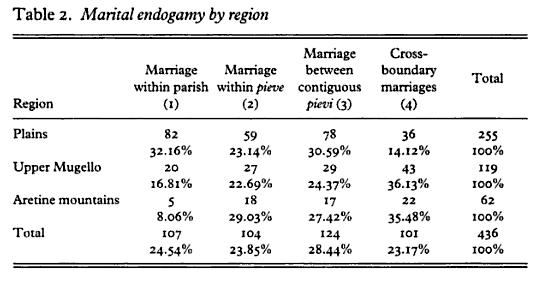there are two broad groups of albanians, the gheg speakers in the north of the country (the blues on the map) and the tosk speakers in the south (the greens):
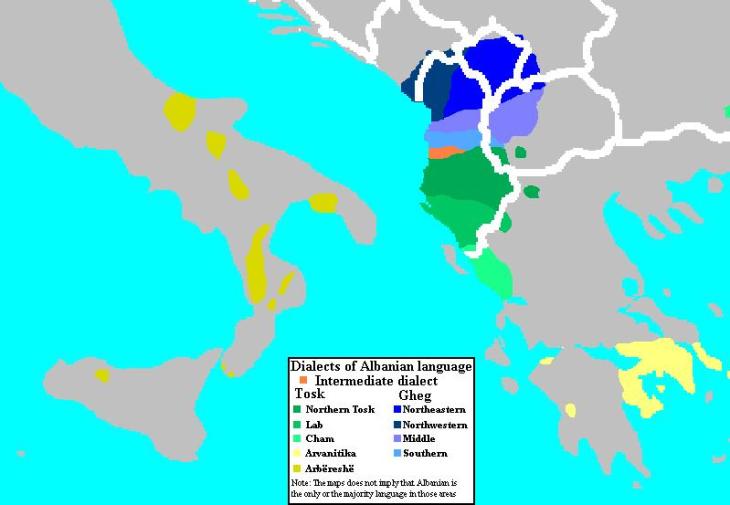
today, the ghegs are more clannish/tribal than the tosks. there are historical (stemming from topographical) reasons for this (emphases and links added by me):
“The social structure of the country was, until the 1930s, basically tribal in the north and semifeudal in the central and southern regions. The highlanders of the north retained their medieval pattern of life until well into the twentieth century and were considered the last people in Europe to preserve tribal autonomy. In the central and southern regions, increasing contact with the outside world and invasions and occupations by foreign armies had gradually weakened tribal society.
“Traditionally there have been two major subcultures in the Albanian nation: the Gegs in the north and the Tosks in the south. The Gegs, partly Roman Catholic but mostly Muslim, lived until after World War II in a mountain society characterized by blood feuds and fierce clan and tribal loyalties. The Tosks, whose number included many Muslims as well as Orthodox Christians, were less culturally isolated mainly because of centuries of foreign influence. Because they had came under the rule of the Muslim landed aristocracy, the Tosks had apparently largely lost the spirit of individuality and independence that for centuries characterized the Gegs, especially in the highlands.
“Until the end of World War II, society in the north and, to a much lesser extent, in the south, was organized in terms of kinship and descent. The basic unit of society was the extended family, usually composed of a couple, their married sons, the wives and children of the sons, and any unmarried daughters. The extended family formed a single residential and economic entity held together by common ownership of means of production and common interest in the defense of the group. Such families often included scores of persons, and, as late as 1944, some encompassed as many as sixty to seventy persons living in a cluster of huts surrounding the father’s house.
“Extended families were grouped into clans whose chiefs preserved patriarchal powers over the entire group. The clan chief arranged marriages, assigned tasks, settled disputes, and set the course to be followed concerning essential matters such as blood feuds and politics. Descent was traced from a common ancestor through the male line, and brides usually were chosen from outside the clan. Clans in turn were grouped into tribes.
“In the Tosk regions of the south, the extended family was also the most important social unit, although patriarchal authority had been diluted by the feudal conditions usually imposed by the Muslim bey….”
_____
here’s a really (REALLY) long excerpt from Poverty in Albania: A Qualitative Assessment with some notes of my own thrown in here and there. the excerpted bits are italicized while my comments are not. the quote from the book comes from pages 83-90. the book itself was published in 2002 and comprises the results of a series of surveys undertaken across albania by world bank researchers in the late 1990s and early 2000s (again, emphases and links added by me):
“Civil Society
“People in all the study sites generally want a capable government that solves problems and creates opportunities. A combination of factors — inadequate government presence, poor management of government functions, corruption, and lack of confidence that elections will change conditions — has created a vacuum of authority in parts of Albania. In certain rural locations, particularly in the north and east, there is no functioning government. In these areas, institutions such as extended families/clans are filling the gaps of authority…. Further, Albanians’ wariness of other groups in general — other families, ethnic groups, and religious groups — fragments civil society and confines non-governmental solutions to local areas….
“Filling the Vacuum
“Two forces are rising to fill the vacuum of government authority — the traditional fis structure, and the small, ad-hoc aid programs of foreign governments and private organizations in some eastern parts of the country….
“The fis is even more important for filling the power vacuum. An elder in Mirdita describes authority there: ‘I am elected elder of this village. The water resources are distributed according to the old traditions, based on the fis. Here things are settled based on the fis, not the state. My fis is composed of my uncle, first cousins, and also fourth cousins. When there is discord that involves injuries … it is not the state that gets involved to resolve the problem, but the wisest of the elderly men in the fis. We discuss how to resolve the problem and develop a consensus. Then we make the decision and the problem is resolved.’
“Re-emergence of the Fis and Canun
“A fis is a group of people descended from the same great grandfather. This extended family is bound together tightly by tradition, culture, and a set of rules called the Canun, which were formalized by Lek Dukagjini in the 1400s. The Canun withered under Communism but has resumed governing importance in some areas. As Remzi, a fis elder in Kukes, explains, ‘The Canun is now starting to function because the government is weak … and the government’s laws are not being properly implemented by the state.’ Fis in some areas are now using the traditional Canun, or a modern variation of it, to govern themselves. As noted in the chapter on agriculture, issues of land reform, land use, irrigation water distribution, and other matters are being determined by the fis structure using the Canun as the basis for decisions….
“Fis are found primarily in northern rural Albania (Kukes, Mirdita, and Shkordra), but they also exist in the highlands of Korca and among the Roma populations….
“Fis Governance
“In each village, there may be as few as 3 or as many as 10 fis. As noted earlier, a fis is defined as a group of those people who descend directly from a common great grandfather. In practical terms, each fis comprises three to four generations. The number of people in each fis can range from fewer than 10 to more than 500 people. The selection of leaders within a fis varies, but there are some common practices. Each fis is led by a male who is elected by other males in the fis. Often the elected leader is the oldest active male, who is responsible for setting and enforcing standards of behavior. He usually does not make important decisions alone, but in consultation with other respected males in the fis, including brothers and sons, and extending to cousins….
**textbox**
“Relations Within and Among the Fis
“‘When someone in our fis makes a mistake, even if he is 40 years old, the entire fis gets together and orders him not to commit further mistakes and put shame on us all. This is our way to preserve tradition. There are seven or eight fis in the village, and we are in competition with each other to be the best one. When one of us makes a mistake or commits a crime, the entire fis is humiliated and its reputation is hurt…. When I have disputes within the fis, I try to resolve them within the fis. But if I cannot do so, I sometimes will invite and elder from another fis to listen to our problems and provide mature judgement. And if we do not get a satisfying result from this, we address the problem to the committee of elders in the village.’ – Hamit, an elder in Shkodra
**close textbox**
“Where the government is totally absent, the committee of elders governs without a government institution by managing common work and the relationships among the various fis. In these situations, the committee of elders uses some version of the Canun to set rules and govern. According to Preng, and elder in Mirdita, ‘I am the elected leader of the fis…. Here, things are settled by the fis and we do not rely on the government. My fis is composed of my uncle, first cousins, and also fourth cousins. When there is a dispute that results in injury, it is not the government that gets involved but the elders who get together and decide the fee. A committee of elders, the wisest men from all the fis, discusses the problem and resolves it based on consensus. When the fee is paid, then the problem is considered resolved…. If the criminal has no money to pay the fee, then he is killed. The fee depends on the issue and how events happened….
“Applying the Canun
“The application of Canun varies by fis. A few apply the traditional Canun, even though they recognize its shortcomings. They feel that, despite the traditional Canun’s weaknesses, it is the best solution in the absence of government. In one area of Kukes, an elder describes the Canun as ‘unprincipled and not fair as the laws. It is very tough and incites disputes and revenge. For instance, according to the Canun, if someone hits you, then you have the right to kill him…. It has some very precise rules, though in today’s society it is hard to implement the rules…. For instance, the Canun does not allow my daughter to bring bread or coffee in the room when guests visit. Women must wear a scarf on their head. A stranger who is visiting your house must not shake hands with your wife or daughter.’ The Canun has returned to an extent that blood feuds have re-emerged. In some areas, such as Shkodra and northern Kukes, families reportedly are confined to their own homes to protect themselves during a feud. In these cases, friends and neighbors bring them food because the family cannot grow their own food or otherwise work while feuding.
“Despite the use of traditional Canun rules in some areas, most fis have adapted the Canun to better fit, in their view, the values of the modern era….
“Dispute Resolution and Other Functions
“… The need for such dispute resolution increased after 1990, due to new freedoms and disputes over property rights, just as the government’s ability to resolves such disputes began to decline…. According to an elder in Shkodra, ‘After 1990, conflict increased compared to the time of my father. The Communist regime caused many fights because it took land from its owners and distributed it equally to everybody, and encouraged people to construct houses on other people’s land….“
albania’s committee of nationwide reconciliation estimates that there were ca. “10,000 murders for honour, blood feud and revenge between 1990 and 2009” in the country, although it’s difficult to know for sure what the real numbers are. i think it’s safe to say A LOT, though. the albanian tradition of gjakmarrja is basically an eye-for-an-eye moral system in which honor is all-important — the honor of the extended family. albanians (and other groups in the balkans) have for centuries had purpose built boltholes to hide in when they and their families were the objects of a blood feud (check out the border reivers’ bastle houses, too):
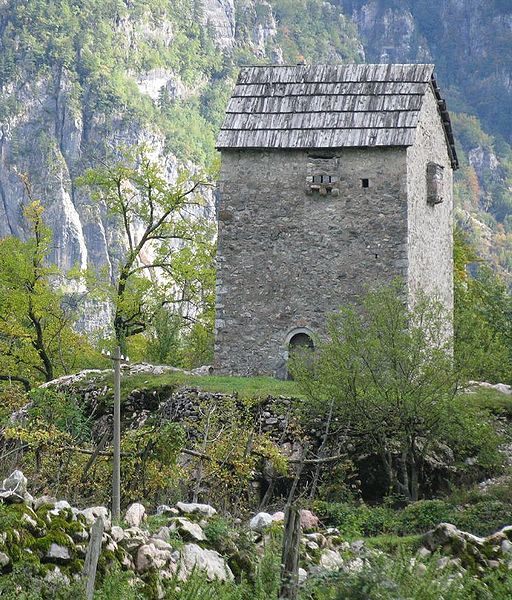
i think the long history and current prevalence of blood feuds in albania and throughout the region illustrates that greying wanderer’s characterization of the balkans as “full of people who hate the people in the adjacent enclosed ancient valley” is not far off the mark.
_____
interestingly:
“Source of Power
“The principle source of power for a fis is its moral standing among the other fis. An elder in Shkodra says, ‘Our moral force and authority derive from good behavior.’ This moral standing is built over generations. Fis that historically have been strong are more likely to enjoy power now. An elder in Shkodra says, ‘Blood is never forgotten. Mother and father have one name. Blood has one name. After 20 or 100 years, the blood of mothers and fathers is not forgotten.’
“Moral standing is judged according to the behavior of the members of a fis. Living according to the laws set by the fis, working hard, being kind and gracious to both neighbors and strangers, showing generosity to others, and having a family that is free of conflict are some of the criteria by which fis judge each other. An elder in Shkodra explains, ‘A good man, according to the Canun, is one who works, is wise, is loved by everybody, who does not humiliate anyone, and who pulls his family together. A bad man is one who does the opposite. The good fis are polite, have culture, and use common sense. A bad fis is not able to run its own affairs properly, let alone enjoy proper relations with other fis.’ An elder in Kukes, who asserts that his family is the ‘best’ fis in the community, describes similar criteria for judging a fis there: ‘My grandfather was known as the representative of the best fis in the village. Now we have 20 families in the village and maybe someone from our fis has committed some wrongs, but we still enjoy the reputation of our generosity and hospitality. For instance, if I see a stranger passing by on the road, I invite him to visit my home and have coffee with us. I preserve the reputation of the fis. When I visit my neighbor, I make a contribution. When he visits me, he makes a contribution. When someone asks to marry my daughter who does not come from a well-respected fis, I do not permit my daughter to marry that person.’
so, unlike in western europe where a man is judged by his character and behavior alone, amongst albanians (and i’m guessing other balkan populations) one’s moral character is all wrapped up with that of one’s extended family. this is something we hear throughout muslim societies in the arab world and middle east as well (e.g. all the honor killings) — not surprising when they are very inbred, too.
_____
“Marriages among members of the same fis are not permitted, even when the two people are seven or eight generations removed. Because one must marry someone from another fis, all marriages involve fis politics. Marriage is very important to determining the stature of a fis in the community. Much time is spent determining the suitability of various suitors, based on the reputation of the fis and the perceived behavior of the prospective bride and groom. Because the reputation of the fis is important to power relations in the community, a woman has little influence in selecting her husband. According to an elder in Kukes, ‘Couples are engaged not through love, but through a mediator….”
since the ban on marrying relations within the fis only applies to paternal relations, it could very well be that albanians frequently marry maternal relatives — close or distant maternal cousins. i haven’t seen any info on this either way for albanians, but another balkan group — bosnian muslims — actually have a preference for marrying in-laws which includes maternal relatives. some albanians are christians (orthodox and roman catholic), so presumably they more-or-less follow the christian ban on marrying close cousins — as a general rule, that is — although all sorts of europeans regularly work around this. there should be no such cousin-marriage ban amongst albanian muslisms.
in any case, albanians are marrying (especially traditionally) very endogamously since they normally marry someone from a fis in the village or, perhaps, a neighboring village.
_____
onwards:
“Wariness of Other Groups
“The re-emergence of the fis highlights the importance of family structures in addressing problems formerly handled by government. But the importance of family is not limited to northern districts and Korca. People throughout the country feel that family affiliations is an important factor in choosing their friends and neighbors. Ethnic and religious affiliation also affect relationships within and between communities. As a result, these groups tend to be wary of each other. Table 12 details people’s attitudes toward their neighbors. [click on table for LARGER view]:

“About 77 percent of people prefer that their neighbors are members of the same fis or family, with 59 percent strongly preferring it. About 52 percent prefer that their neighbors share the same religion, while about 44 percent prefer that neighbors are of the same ethnicity. It appears that family affiliation is more important than religion or ethnicity in determining feels [sic] about neighbors.…
“The civil society that either shares space with government or fills a vacuum left by government comprises a series of groups that are wary of each other and sometimes conflict. Consequently, there are few informal institutions, organizations, and networks that cross large geographic areas. Those that do exist, such as the emigration networks into Greece and Italy, are based on single extended families or single local communities. So while informal institutions and organizations are significant assets, they may be limited in their capacity to address problems across different families, religions, and ethnicities.”
like other clannish/tribal societies, albania doesn’t manage to have a civil society. not in the sense that nw europeans have. clannishness and tribalism seem to go along with inbreeding — either consanguineous and/or endogamous mating patterns — and i think the causation goes from inbreeding -> clannishness/tribalism (although certainly being clannish probably encourages further inbreeding). and the underlying mechanism is, as steve sailer pointed out ages ago, somehow related to kin selection and inclusive fitness.
albanians seem to be some of the most inbred peoples in europe — looking at their genomes, they have the highest frequencies of within-country “blocks of ibd” (identity by descent) as compared to other europeans which suggests to me that they’ve been inbreeding for a long time, too. that, i think, is part of the reason for the high ibd rates amongst albanians. given their history, then, it shouldn’t be surprising that they still are very clannish/tribal and don’t manage to build a civil society.
_____
see also:
– Albania: Blood Feuds — ‘Blood For Blood’ (Part 1)
– Blood feuds still boiling in Albania – feuding taken to a new level when a 17 year old girl is killed.
– Ancient blood feuds cast long shadow over hopes for a modern Albania
– Peacemaker breaks the ancient grip of Albania’s blood feuds
– No way out
– The Forgiveness of Blood – movie.
_____
previously: balkan endogamy
(note: comments do not require an email. albanians.)



